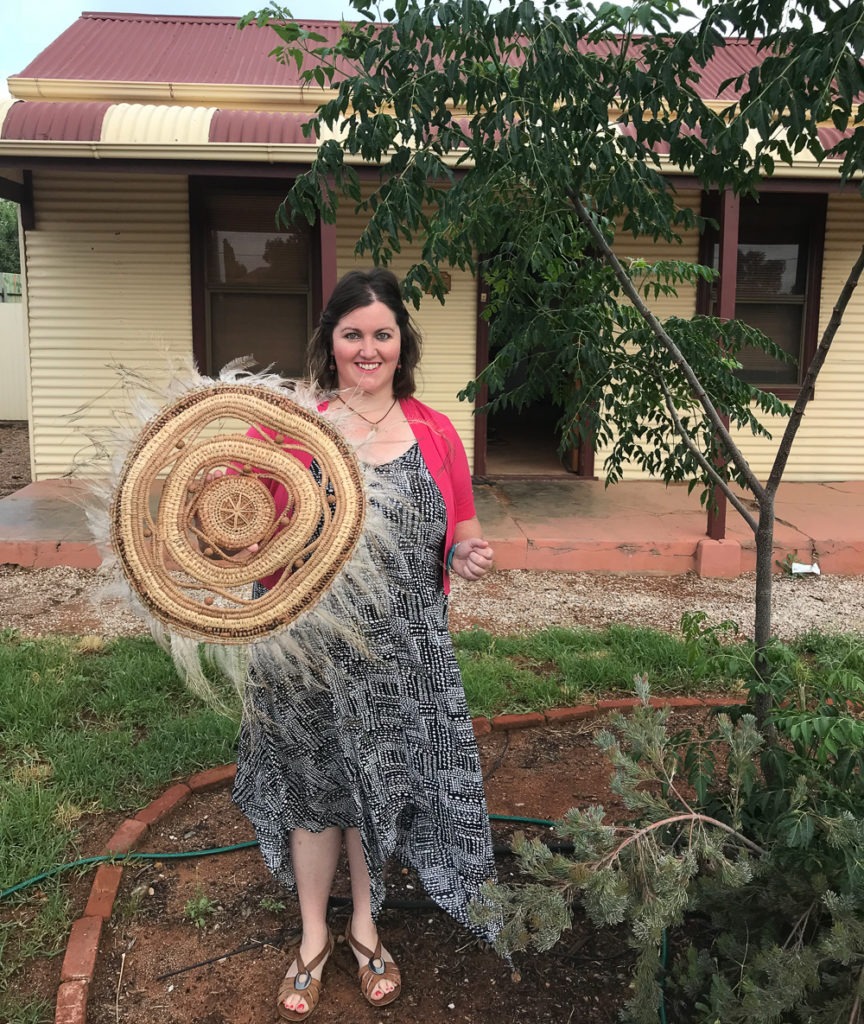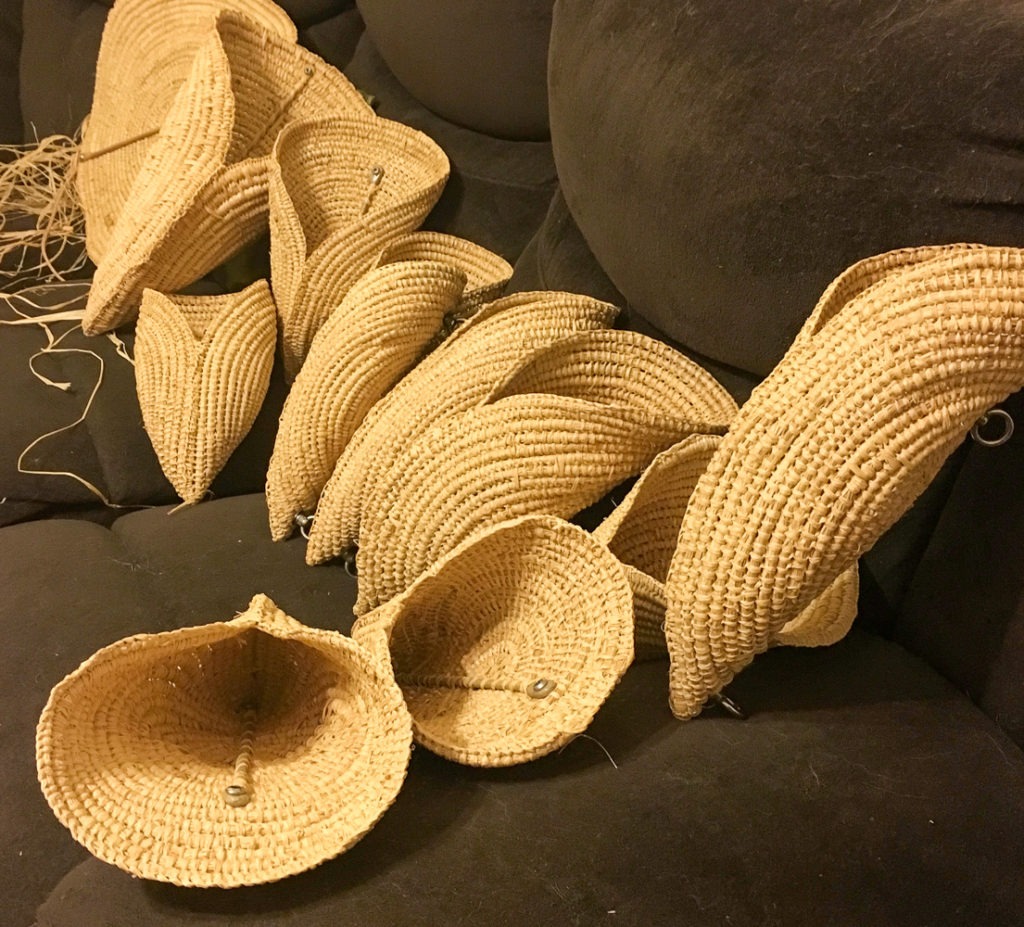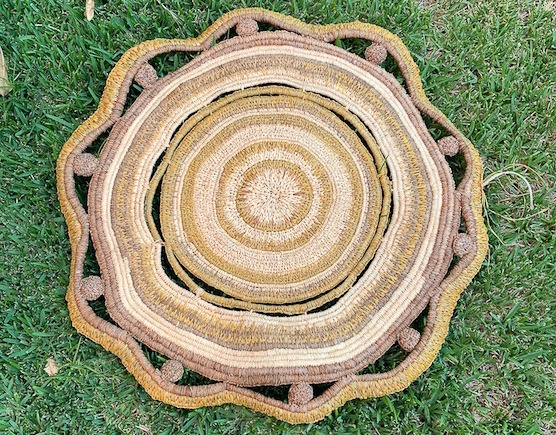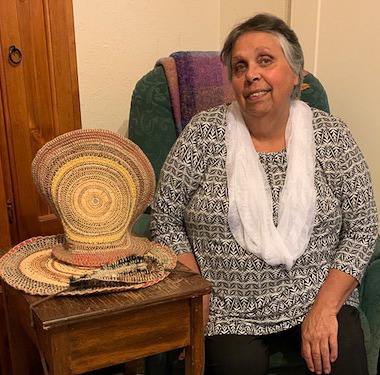Jules Christian reflects on how weaving helps her cope with the fear of abandonment that is a legacy of colonisation.
(A message to the reader in the Darug language from Jayne Christian.)
Weaving is a central ingredient in my life. As a Burramattagal woman from the Darug Nation, spending time together with other Aboriginal women becomes one of the most enjoyable past-times that I have. As a small group of strong women in Wagga, NSW, we sit together and become lost in a collective time; laughing, sharing, and yarning. Spiritually, this time and practice together is powerful. It is uplifting as each woman comes together to heal as just one small component within a collective “now”. Passers-by, to our amusement, comment on the laughter they hear. Circling us is a hectic life that continues to tick by, waiting for us to re-enter its madness, but unable to penetrate this time together.
Sitting together weaving is practising our cultural healing. Our collective “now” also calls us in times of sorrow and hardship, when an Aboriginal feminine strength surfaces, a “knowing” that comes by “doing” what comes naturally to us—being in the “being”. This is a time where no-one exists outside our circle. We walk together on this common ground sharing through love, not jealous competitiveness. Our sisterhood of sharing takes us back to a place of collectively honouring our old ones, exactly how they honoured their old ones within their time. This practice is taught to our children. What is important to me is this practice is respectfully done through sharing deep sacred knowledge and time, not money sprinkled with ulterior motives.
Commonality
My English and Irish ancestries have been well-researched. My Danish ancestry is a blur, still to be researched extensively. But my Aboriginal ancestry has been heavily researched by many and is the glue that fuses my English, Irish and Danish ancestries together.
My Aboriginal ancestral line pre-dates colonisation. In 1813 a girl was born at Parramatta (known widely by its Aboriginal name, Burramatta). Taken from her parents at eight years of age, Christianised, then married off to an English man, she bore him thirteen children. She is buried with her husband in an unmarked portion beside him.
History shows Aboriginal girls were taught to sew, though I cannot help but wonder how her life would have panned out if she had mastered weaving or, in fact, if she had secretly mastered this practice how she felt about it. Something stirs within me when I weave and think of her. This stirring emotion creates the weaving that I do. It is my connection to her and my other ancestors that creates my objects.
In contrast, my time spent with non-Aboriginal women sitting around a kitchen table knitting and sharing quilting patterns and ideas is pleasing. I take my weaving along but there are long pauses between the weaving stitches. This is a respectful time shared with women born of a different culture, and one I was also born into. Within this feminine space of commonality, I find the conversations differ within its own perspective of viewing space and time. Again, we combine our knowledge and create colourful and delightful garments and blankets, all measured and refined within a scripted pattern. This time is pleasing but colonised, and the practice does not feel as comfortable to me as my weaving. No doubt if I called on any of these beautiful women for assistance they would come to my aid. But my weaving sisters are beside me, filtering the void of experiencing a sense of abandonment.
This feeling of abandonment stems from the trauma of disconnection experienced throughout my family’s Aboriginal lineage. It is a sense of fear of being left, or taken; a waiting through separation, a disconnection that is imprinted within my mind’s memory. But there is an uncanny sense of commitment between women with lives of abuse and hardship that sees each of us take on, within our shared space, a caring, nurturing calmness of understanding that stays within us, for each other.
- Julie-Ann Christian, Scoops
- Julie-Ann Christian
Why I favour weaving?
Indigenous women throughout the world have developed their styles of weaving. It is unique to the tools, and plants/fibres they use. Weaving has practicality when manipulating the fibre by hand, leg and foot with an earth-produced variety of trees, shrubs and grasses. Objects created allow for self-satisfaction, social acceptance, and social support. Culturally, weaving practices surround the teaching of children at a very small age. The knowledge of weaving is witnessed by the small child that becomes a stable environment, in contrast to such practices like knitting, that does not appear to have the same learning experience until a later stage of the child’s life.
Weaving becomes a communicative social method for women. To sit with each other, sharing our stories, supporting each other and passing on knowledge to children in our care. Culturally this is a time of uplifting action undertaken within the group and is extended to visiting women who ask to join.
Culturally the similarity in creating first, then gifting an object, continues to be practiced within Indigenous cultures worldwide. This practice was carried out prior to colonisation through weaving a connection to others in ceremony. Therefore, creating first, then gifting an object through the weaving practice is considerably more powerful because of its connections to both the land, self and spiritual understandings of all Indigenous peoples worldwide. In 2019 I travelled to Norfolk Island and was privileged to learn of the traditional weave and plaiting practices. Again, the cultural practice of gifting by the Norfolk Islander women who create hats in the traditional weave, gift these hats to their Elders as a mark of respect. This significant ceremony becomes part of their blood and is taught to the descendants of Norfolk Islander peoples.
I was introduced to the weaving technique of the Ngarrindjeri peoples of the Murray River and Coorong regions in South Australia. This technique was traded-up to women of Arnhem Land, and the NSW south coastal areas. Weaving traded in the Sydney area in periods that pre-dated colonisation are evident in the rock engravings. A woman with her dilly bag is depicted within the rock engravings and I believe gifting forms part of the Dreaming inclusive of these objects. It is feasible to comprehend respectful, spiritual and cultural values between language groups where honouring did occur.
Weaving practice
- Pamela Honeysett
- Evelyn Jolley
The Aunties and I who share cultural practice create our own objects. Each is a beautiful creation, and we call these creations, “vessels of love”. I harvest and prepare my own bush dyes and through Indigenous Knowledge of plants fused together create texture and image through an array of colours. The act of responsible harvesting and acknowledging the fibre and the country does not deplete supply. In turn weaving becomes heavily reliant on the cycle of seasons for plant replenishment. I also use different commercial fibre depending on the object that I am creating.
The art of weaving is valued for its healing qualities, portability and that it still is fairly inexpensive. Weaving can be done by male, female, old and young. Oftentimes fibre is growing right in front of us. Therefore, with little preparation needed for natural grasses, it becomes an inexpensive practice, coupled with the Aboriginal traditional spinning technique, popularly known as, twining.
Culturally, I only take from country what is needed at that time. To me, weaving has no printed patterns, as in knitting. Weaving is crafted through a collective energy within the woven object that comes from the weaver herself. Therefore, the object becomes part of the weaver – making the object a highly sought-after gift. My weaving creates its own path using me as its instrument to tell its story. Each creation has its own journey that becomes a part of my own journey.
Author
 I am a Burramattagal woman of the Darug Nation, but I have lived most of my life on Wiradjuri Country, at Wagga Wagga, NSW. I have been blessed to have formed connections with strong Wiradjuri women. Although living off-Country I have never felt a disconnection from my own traditional Darug Country. My weaving has been exhibited at various venues, and I have participated in many workshops and demonstrations for the young and old. Currently, I am studying Indigenous Research at Deakin University. My future goal is to expand further in Indigenous research through decolonisation which is a central theme to my studies.
I am a Burramattagal woman of the Darug Nation, but I have lived most of my life on Wiradjuri Country, at Wagga Wagga, NSW. I have been blessed to have formed connections with strong Wiradjuri women. Although living off-Country I have never felt a disconnection from my own traditional Darug Country. My weaving has been exhibited at various venues, and I have participated in many workshops and demonstrations for the young and old. Currently, I am studying Indigenous Research at Deakin University. My future goal is to expand further in Indigenous research through decolonisation which is a central theme to my studies.
A cultural practice within my family is to look after the mothers and grandmothers in older age. This practice signifies the importance of sharing cultural practices and knowledge to our young women who become our future strength. I share these practices with Aunty Evelyn Jolley and Aunty Pamela Honeysett, who join me in our little weaving circle which is very valuable in time and tradition. We come together to weave, share and strengthen our cultural connections.










Comments
Absolutely beautiful read. So very lucky to have women like yourself and your daughter paving the way for those in similar situations. Being Birn and growing up on Wagga Wagga and also being apart of Darug nation, you give me hope that lost generations who want to find their way back and reconnect can do so. And to be able to learn from such caring people with out judgment really brings hope to myself. Thank you for sharing and allowing others to listen. One day I would love to sit and yarn and learn how to weave and the processes it has.
Thank you so much for this story. Your descriptions of the communal and healing aspects of weaving made me look at it differently, especially when you described the bond between your weaving sisters.